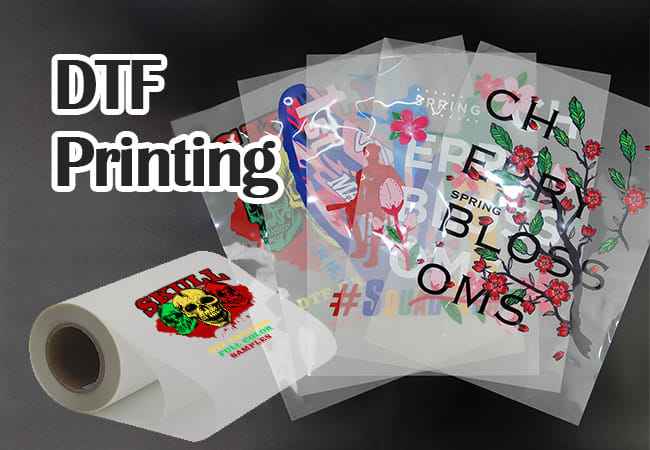Mastering DTF Printing: A Comprehensive Guide to Direct-to-Film Techniques
Mastering DTF Printing: A Comprehensive Guide to Direct-to-Film Techniques
Blog Article
The Future of Fashion: Discovering DTF Printing Technology in the Fabric Industry
Amongst these improvements, Straight to Movie (DTF) printing modern technology has emerged as an encouraging contender, offering special abilities and opportunities for developers and producers alike. This innovative printing approach has actually sparked interest due to its potential to reinvent conventional textile printing processes.
Development of Textile Printing
From the ancient human beings utilizing strategies like block printing to the electronic revolution of today, fabric printing has continually pressed limits. As the craft spread to various other components of the world, brand-new methods such as display printing and roller printing emerged throughout the Industrial Transformation, revolutionizing the fabric industry.
The introduction of digital textile printing in the late 20th century marked a substantial change towards more lasting and functional printing approaches. The evolution of textile printing showcases a rich background of creative thinking, ingenuity, and technological development in the globe of style and layout.
Benefits of DTF Technology
With the development of textile printing strategies from old approaches like block printing to modern advancements such as electronic printing, the intro of Direct-to-Fabric (DTF) modern technology has actually significantly improved the performance and sustainability of fabric printing procedures. One of the primary benefits of DTF technology is its capability to directly print styles onto material without the requirement for transfer papers, which decreases waste and simplifies the production process. Furthermore, DTF printing enables higher color vibrancy and detail accuracy contrasted to conventional methods, making it possible for textile manufacturers to develop high-quality and complex styles easily.
Furthermore, DTF modern technology is recognized for its adaptability, as it can be utilized on different kinds of textiles, including natural fibers like wool, cotton, and silk, along with synthetic materials such as polyester and nylon (DTF Printing). This flexibility opens a large range of opportunities for designers and producers to experiment with various appearances and materials, bring about even more special and cutting-edge products in the fashion business. On the whole, the implementation of DTF innovation represents a significant innovation in textile printing, supplying many benefits that contribute to the future sustainability and creative thinking of the sector
Sustainability in vogue Manufacturing
Emphasizing green techniques is vital in modern fashion production, lining up with the expanding consumer demand for sustainable items. In recent times, the fashion business has encountered enhancing analysis because of its considerable ecological effect, including excessive water usage, chemical pollution, and textile waste. As a feedback, several fashion brand names are currently incorporating sustainable methods right into their production procedures to reduce damage to the setting.
Sustainability in fashion manufacturing includes different aspects, such as making use of organic and recycled products, lowering energy usage, applying ethical labor methods, and promoting transparency throughout the supply chain. Furthermore, advancements in modern technology, like DTF printing, offer opportunities to further boost sustainability in fabric manufacturing. This modern technology makes it possible for specific printing on fabrics, reducing ink waste and useful site water usage compared to typical printing techniques.
Layout Freedom and Personalization

In addition, DTF printing promotes personalization on a range formerly unattainable, allowing for customized clothes and one-of-a-kind items customized to individual preferences. Generally, DTF printing technology revolutionizes the style landscape in the textile industry, providing limitless opportunities for creative expression and tailored style.
Effect On Supply Chain & Market Trends
DTF printing modern technology in the fabric market is improving supply chain dynamics and affecting market patterns via its effectiveness and customization capacities. By allowing on-demand printing and removing the requirement for huge supplies, DTF innovation improves the supply chain procedure. Manufacturers can generate items as needed, reducing waste and storage space expenses. This just-in-time manufacturing design additionally permits quicker action to market needs and trends, causing a more nimble and receptive supply chain.
In addition, the customization potential of DTF printing technology is transforming the market fads in the textile sector. As a result, DTF technology is driving a change towards even more customer-centric and innovative approaches within navigate here the fabric industry, forming the future of fashion.

Conclusion
Finally, DTF printing modern technology is revolutionizing the fabric sector by offering numerous advantages such as layout freedom, customization, and sustainability. This ingenious modern technology is improving the future of fashion production, influencing supply chains, and driving market trends in the direction of extra reliable and eco-friendly methods. As the market proceeds to develop, DTF printing will certainly play a crucial duty in shaping the method textiles are generated and consumed in the years to find.
From the ancient civilizations utilizing strategies like block printing to the electronic change of today, textile printing has constantly pushed borders. As the craft spread to other parts of the globe, brand-new methods such as display printing and roller printing emerged throughout the Industrial Revolution, reinventing the fabric market.
The introduction of digital textile printing in the late 20th century marked a considerable shift towards more flexible and sustainable printing methods.With the evolution of textile printing techniques from ancient techniques like block printing to modern advancements such as electronic printing, the introduction of Direct-to-Fabric (DTF) innovation has substantially enhanced the efficiency and sustainability of fabric printing processes (DTF weblink Printing).In action to the imperative shift towards sustainability in fashion production, the adoption of innovative modern technologies like DTF printing not only addresses environmental issues yet also opens up methods for unmatched style freedom and customization in the fabric market
Report this page